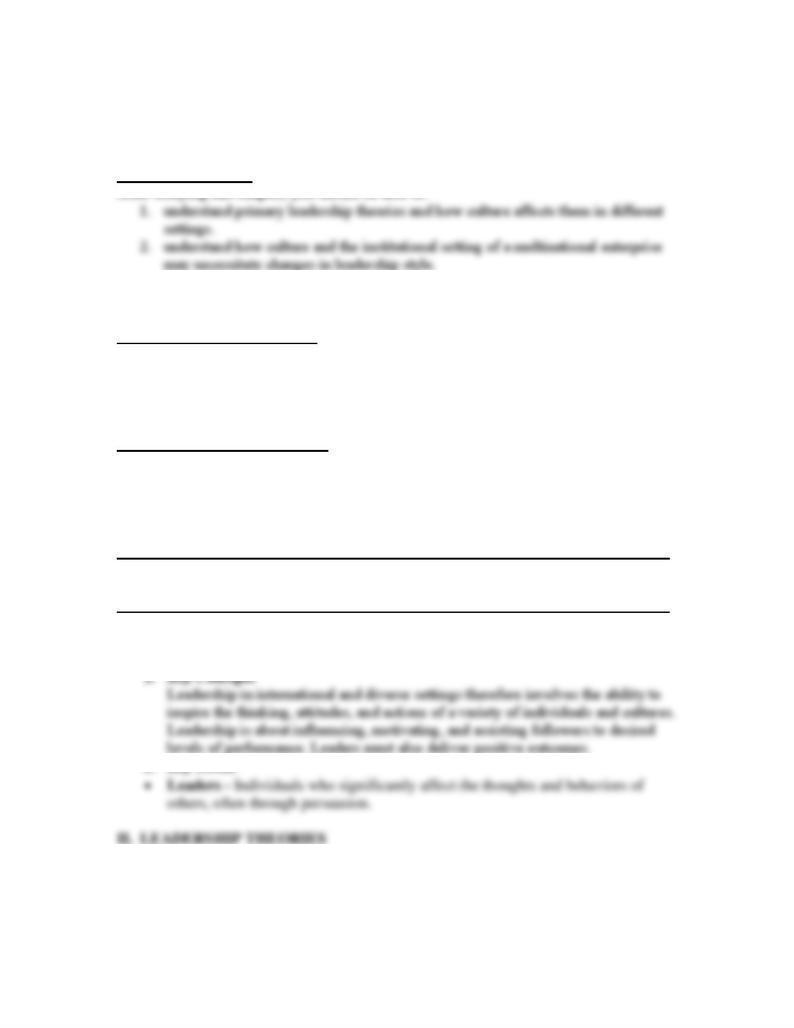
INTERNATIONAL MANAGEMENT Chapter 8: Leadership
57
Chapter 8
LEADERSHIP
Learning Objectives
3. distinguish different traits, competencies, and behaviors that leaders require when
working with different cultures and strategic situations.
General Teaching Suggestions
Divide the class into groups. Each group should identify a leader from any field and
describe the factors that worked behind the success of the person. The facilitator shall
identify the theories behind the observations and hint at their role. The explanation of
these theories should proceed in line with the sequence of the text.
Opening Case Discussion Guide
The case describes the image of Chinese culture as provided to American and European
cereal makers during their attempts to enter the Chinese market. A leading U.S. cereal
maker decides to implement individual rewards which go against the spirit of
emphasizing the collective, which according to the consultants contradicted the Chinese
tradition. The success of this attempt leads to a new learning for marketers.
_______________________________________________________________________
CHAPTER OUTLINE: KEY CONCEPTS AND TERMS
Sections I through V of Chapter 8
_______________________________________________________________________
I. WHAT IS LEADERSHIP?
2. Key Terms
1. Key Concepts
• Trait Theories of Leadership
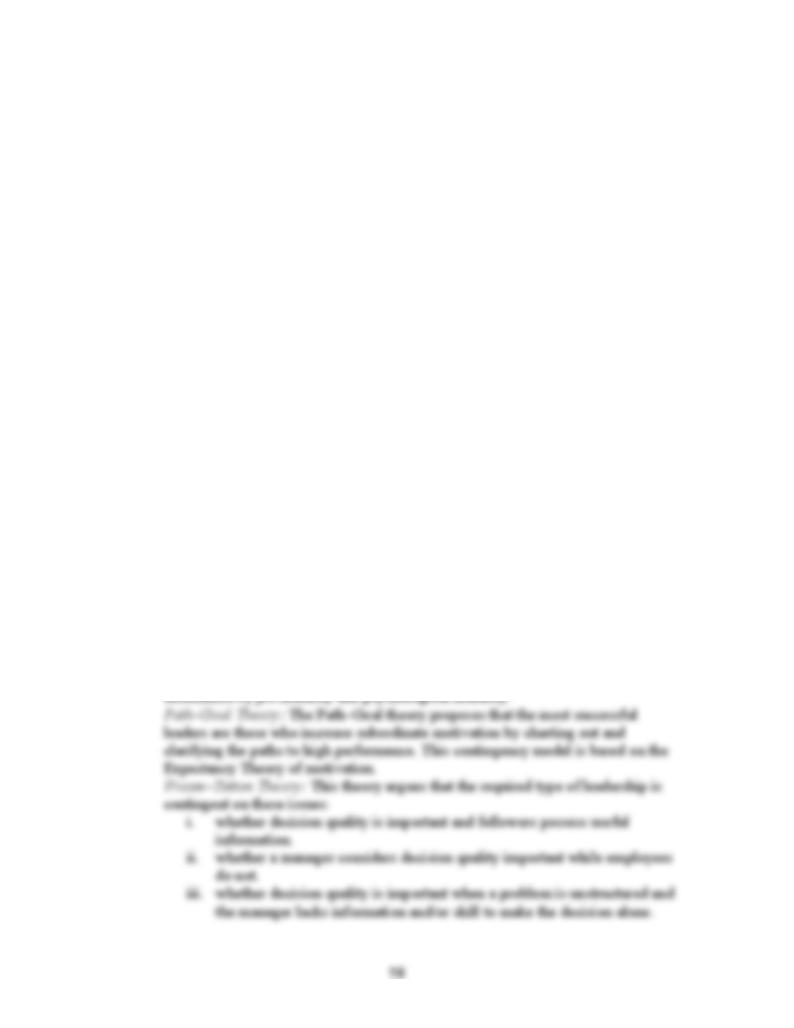
INTERNATIONAL MANAGEMENT Chapter 8: Leadership
Charisma: Charisma is the ability to inspire or influence others. Charismatic
leadership that combines learned skills with the ability to transform an
organization, in addition to internal traits, is referred to as transformational
leadership.
Transformational versus Transactional Leadership: Transformational/charismatic
leadership is traditionally contrasted with transactional leadership; Bernard Bass
defines a transactional leader as one who recognizes follower needs and tries to
see that the organization satisfies those needs if employee performance warrants
it.
• Behavioral Theories of Leadership
Ohio State/Michigan Studies: The behavioral perspective of leadership identifies
two dimensions of leader behavior: task orientation and people orientation. This
perspective has been used to argue that the most effective leaders exhibit high
levels of both types of behaviors, irrespective of a given situation.
Leadership Grid: Leadership Grid has categories based on a 9 by 9 matrix. This
grid identifies various types of leadership behavior based on two independent
dimensions of concern for production and concern for people.
International Perspectives on Behavioral Theories: There is evidence that
different cultures will find different positions on the Leadership Grid to be most
effective.
• Contingency Theory
Fiedler’s Contingency Theory: Fiedler argued that there are two fundamental
types of leadership: task orientation and relationship orientation. The best
leadership style is determined by three conditions or contingencies. The first
contingency is the leader-member relationship. The second contingency is task
structure, which is the degree to which employees’ tasks are routine, in contrast to
varied tasks. The third contingency is the power inherent in the leadership
position.
Hersey–Blanchard Situational Leadership: They argued that contingency was the
appropriate approach because it allows flexibility in types of leadership as
required in different settings. Specifically, they argued that effective leaders must
also vary their style of leadership based on the employees’ level of maturity.
There are four levels of employee maturity. An employee’s maturity is
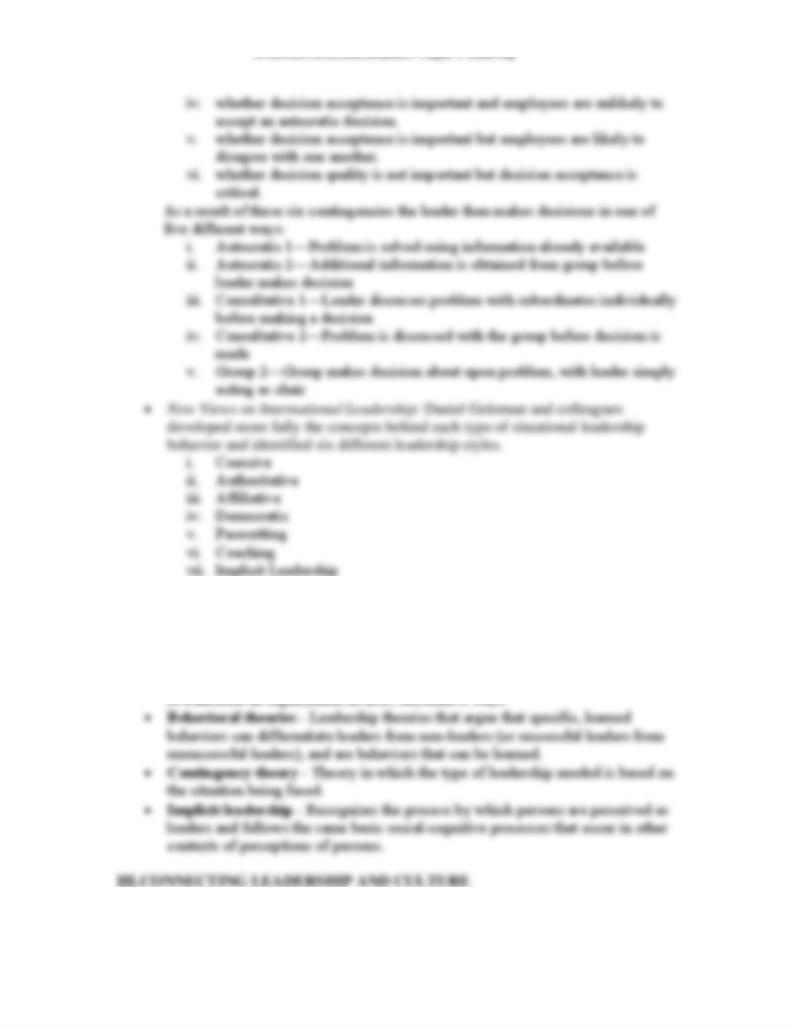
INTERNATIONAL MANAGEMENT Chapter 8: Leadership
59
2. Key Terms
• Trait theory - Argues that people have underlying traits or characteristics that
lead to either superior leader or follower performance.
• Internal locus of control - Whether people feel that they can control things
themselves or whether forces outside them control their future.
• Transformational leadership - A combination of learned skills and the ability
to transform an organization in new, substantive ways.
1. Key Concepts
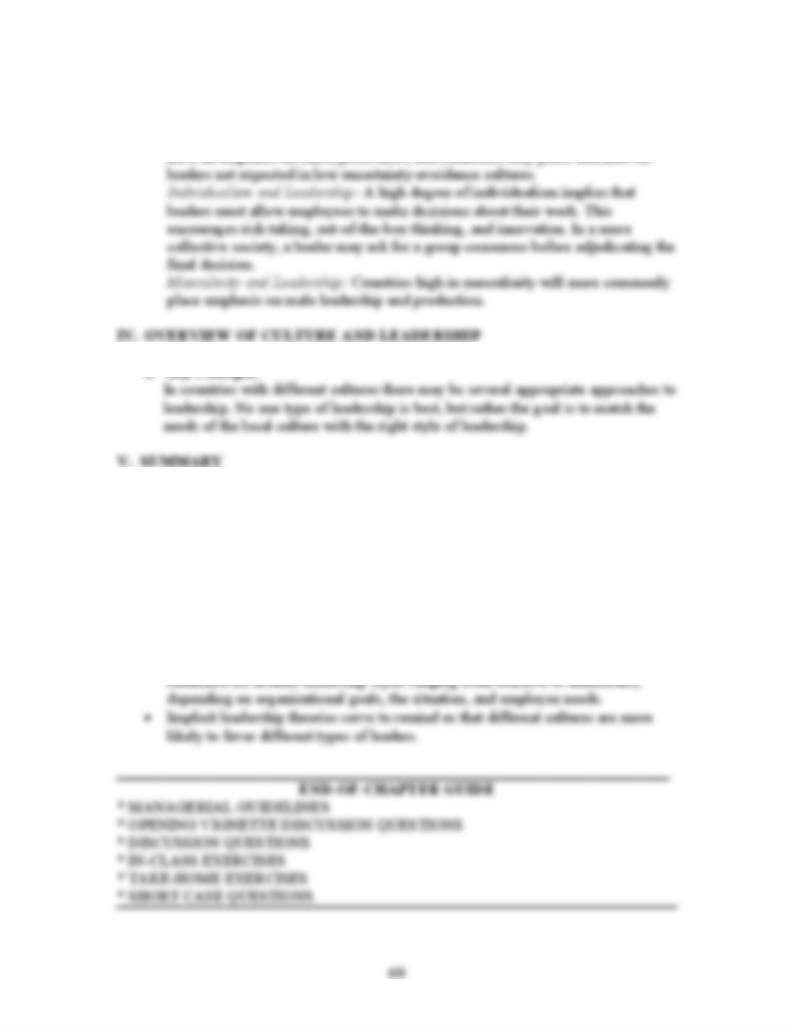
INTERNATIONAL MANAGEMENT Chapter 8: Leadership
Power Distance and Leadership: Hofstede argued that participatory leadership is
not suitable for all cultures.
Uncertainty Avoidance and Leadership: High uncertainty-avoidance cultures that
1. Key Concepts:
• It is critical that businesspeople recognize that culture dictates the leadership
approach.
• Originally, there were two main behavioral leadership dimensions: task
orientation and people orientation. Subsequent research on other key conditions
has given more depth and detail to the behavior model of leadership.
• Contingency models of leadership, including the Path–Goal and Vroom–Yetton
theories have been developed that help differentiate the situations under which a
leader should be more directive or democratic in decision-making.
• Recent empirically grounded work by Daniel Goleman and colleagues has
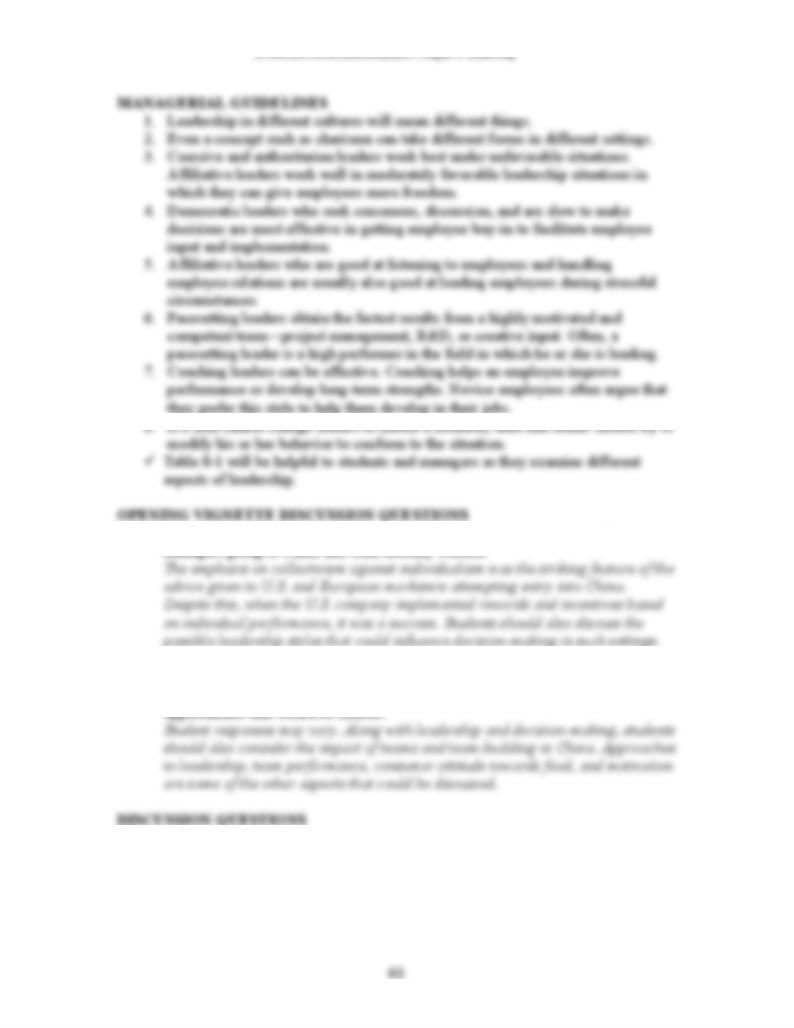
INTERNATIONAL MANAGEMENT Chapter 8: Leadership
1. Why do you think there are differences in the theoretical advice offered to the
2. As you think about the potential for developing a major new market for cereal in
China, what might be some other domains that may offer similar major market
1. Discuss what you think an effective leader would be like if you were in Australia.
Contrast that with what an effective leader would be like in India.
The concept of ‘‘mateship,’’ the leader being ‘‘one of the boys,’’ was one of the
typically Australian leadership dimensions that reflects the high value placed on
egalitarianism and a leader’s ability to earn respect through his or her skills, not
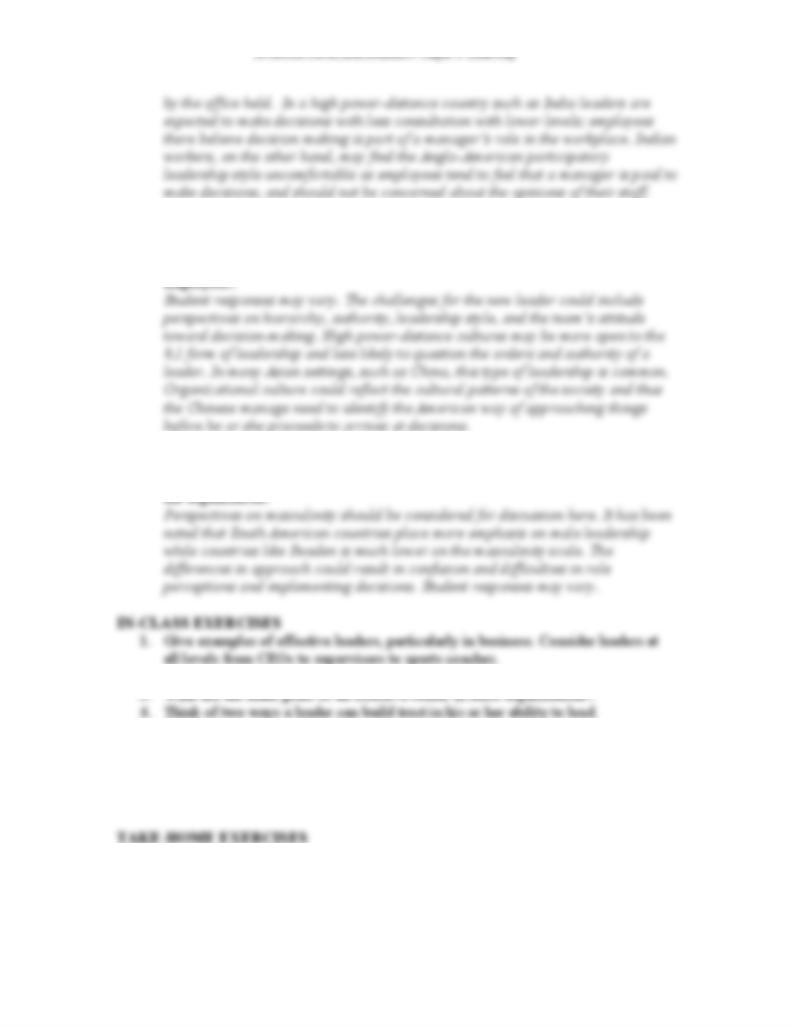
INTERNATIONAL MANAGEMENT Chapter 8: Leadership
62
2. What would be the potential leadership problems a Chinese manager at Lenovo
might encounter as he or she moves into a senior management position at the
firm’s new New York offices, where he or she will work with former IBM
3. If a South American manager is sent to manage a joint venture in Sweden, what
would be the potential problems that he or she could encounter in seeking to lead
2. What do effective leaders do?
5. The article describes the incident of a corrective punishment that occurred in
Japan: Faiola, A. (2005, November 30). ‘‘U.S. baseball manager’s softer style
throws Japan’s social order a curve.’’ The Wall Street Journal (Asia). What type
of leadership style is this company employing? Do you think it will be effective in
Japan? How about in western countries, such as the U.K. or the U.S.?
1. Several management scholars have argued that charisma is not enough for
someone to be a leader. Explain why they argue this.
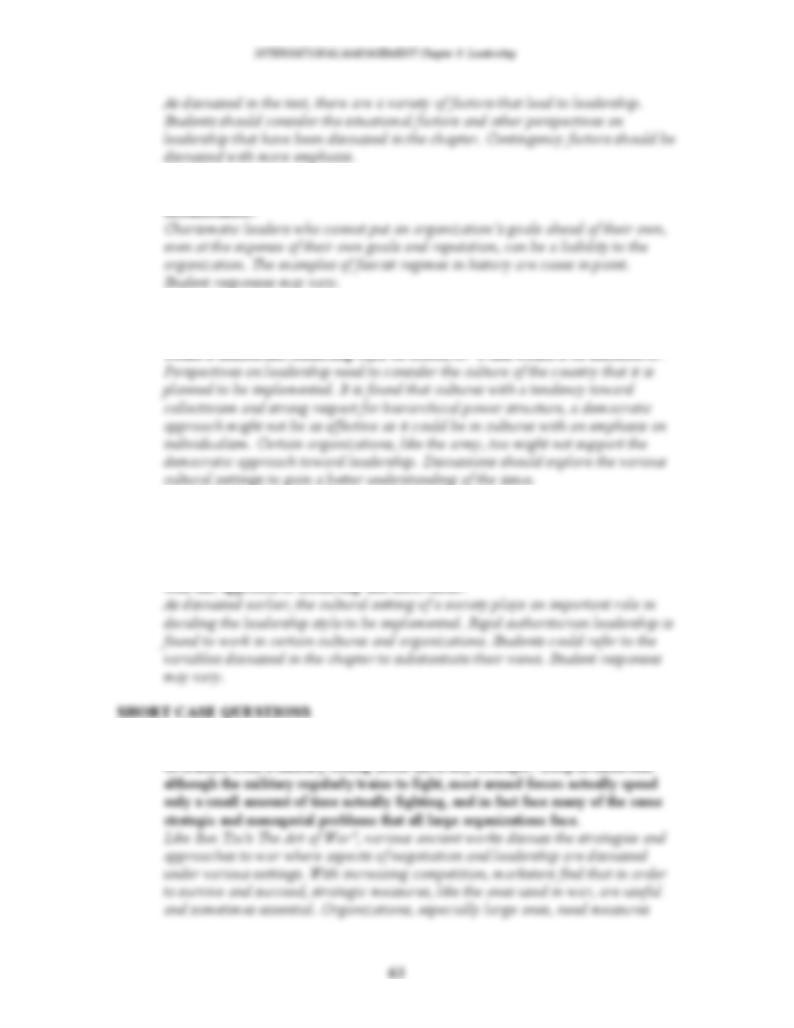
2. How could charisma actually hinder a leader from being effective and under what
3. Many people from the West would argue that democratic leadership in which the
leader gives followers a say in decisions is the preferred leadership style. When
4. In Japan, China, and many other Asian countries, a tough, autocratic leader is
thought to be necessary to motivate the workforce. Many leaders (including
managers, coaches, teachers, and even parents) believe that praise to followers
should rarely if ever be given. Why do you think this is the case? Do you agree
1. Studying military history is recommended to learn more about issues such as
training, strategy, logistics, management, and leadership. What do you think can
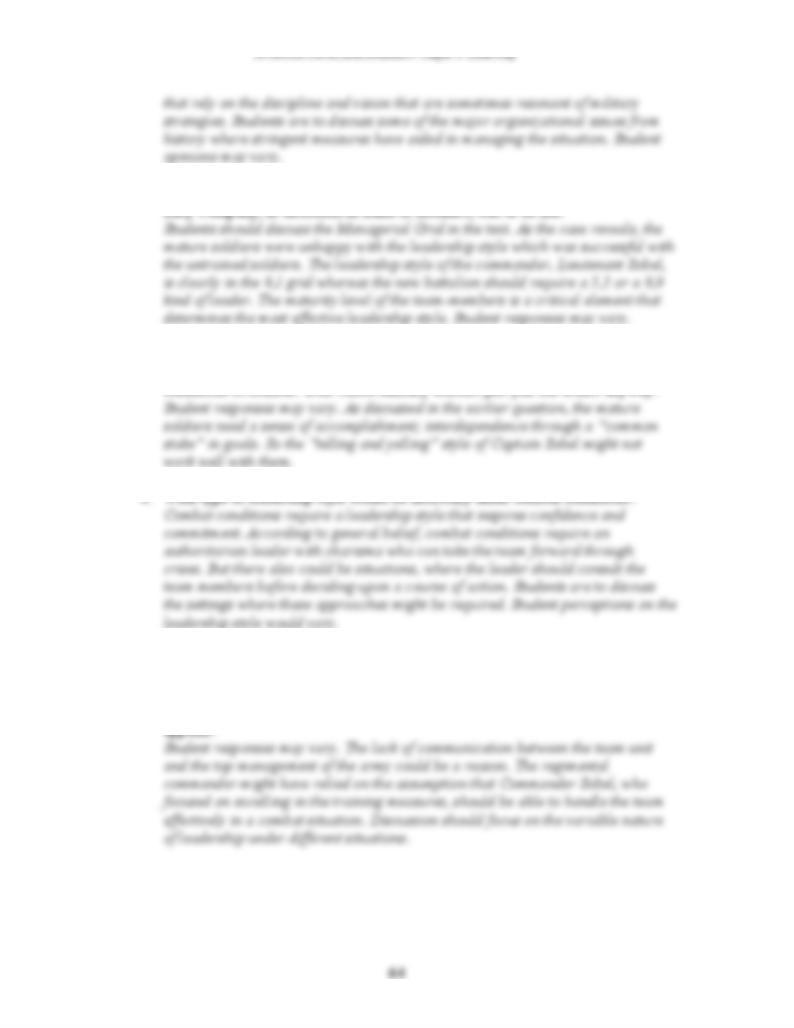
INTERNATIONAL MANAGEMENT Chapter 8: Leadership
2. Why did the invasion of Europe in WWII (D-Day) require a change in the way
3. Why do you think the ‘‘telling and yelling’’ style of Captain Sobel, the
commanding officer of Easy Company, would not have worked well under
5. Why do you think the regimental commander (Captain Sobel’s boss, Colonel
Sink) was unaware of Sobel’s failings as a leader? What measures was he relying
upon to judge Easy’s performance? What does this say about how managers
should assess the performance of their units and the fitness of the leaders they